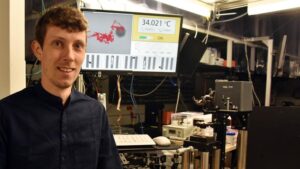Clever method for separating nano-components

Golden nanoparticles (hexagonal shape) are bound to metal strips (shown in color) by binding Casimir forces. By immersing in a binary mixture that segregates at higher temperatures (red, blue bubbles), they are released from the substrate again.
Credit: Dr Falko Schmidt
Physicists at Friedrich Schiller University Jena together with European colleagues find a solution for the controllable separation of the undesired bonding between nano-components.
Physicists from Friedrich Schiller University Jena, together with colleagues from Düsseldorf, Gothenburg, Lyngby and Trieste have developed an ingenious solution for separating bonded nano-components.
Their idea is to immerse the nano-components in a solvent near its critical point. In the experimental setup, they succeeded in separating the components in a controllable fashion by only changing the temperature of the solvent. The authors present their successful experiment in the scientific journal “Nature Physics”.
Components separate at the critical point of the solution

Anne Günther/Universität Jena
“We were looking for a solution to eliminate the undesirable static friction of the individual components in a nano electromechanical system (NEMS) rubbing against each other,” explains Dr. Falko Schmidt from the University of Jena’s Institute of Applied Physics. This static friction is called stiction – a compound of the terms static and friction – caused by what are called quantum-electrodynamic Casimir forces. These forces are the result of fluctuations and inevitably cause the components to stick together. The researchers developed a method to reverse this effect by immersing the components into a critical solution – a mixture of water and oil – in which fluctuations also occur. The strength of these fluctuations can be precisely controlled by changing the temperature.
“The special feature here is that we don’t suppress the original fluctuations, but replace them with other, much stronger ones,” says Falko Schmidt. The desired effect was achieved in the experiment with the help of a heatable microscope objective. The researchers were able to hold a gold nanoflake above a structured metallic substrate. Normally, the gold flake would stick to the substrate. When the surrounding liquid approaches the critical point – the temperature range in which water and oil segregate – the fluctuations are so strong that stiction is avoided. The research group concludes this could be so effective that bonded components could be separated and made movable again.
A long road to solving an obvious problem
Dr. Falko Schmidt conducted the experiments while still at the University of Gothenburg, where he also developed new experimental methods that ultimately led to success. “We quickly came up with the idea for this project, as this problem was clearly evident from nano-manufacturing,” says Schmidt. However, the road to the solution was a long one. It was the approach of dominating the critical Casimir effect with the quantum-electrodynamic Casimir effect that ultimately prevailed.
The aim is to apply the idea of freeing micro and nanoelectromechanical systems from blockages due to mechanical friction in the future, making it therefore possible to further develop new effective function-oriented nano-components.
Wissenschaftliche Ansprechpartner:
Dr Falko Schmidt
Institute of Applied Physics of Friedrich Schiller University Jena
Albert-Einstein-Straße 7, 07745 Jena, Germany
Telephone: +49 (0)3641 / 947986
E-mail: schmidt.falko@uni-jena.de
Originalpublikation:
F. Schmidt, A. Callegari, A. Daddi-Moussa-Ider, B. Munkbhat, R. Verre, T. Shegai, M. Käll, H. Löwen, A. Gambassi, G. Volpe, “Tunable critical Casimir forces counteract Casimir-Lifshitz attraction”, Nature Physics, (2022), DOI: 10.1038/s41567-022-01795-6
Weitere Informationen:
Media Contact
All latest news from the category: Physics and Astronomy
This area deals with the fundamental laws and building blocks of nature and how they interact, the properties and the behavior of matter, and research into space and time and their structures.
innovations-report provides in-depth reports and articles on subjects such as astrophysics, laser technologies, nuclear, quantum, particle and solid-state physics, nanotechnologies, planetary research and findings (Mars, Venus) and developments related to the Hubble Telescope.
Newest articles

Innovative 3D printed scaffolds offer new hope for bone healing
Researchers at the Institute for Bioengineering of Catalonia have developed novel 3D printed PLA-CaP scaffolds that promote blood vessel formation, ensuring better healing and regeneration of bone tissue. Bone is…

The surprising role of gut infection in Alzheimer’s disease
ASU- and Banner Alzheimer’s Institute-led study implicates link between a common virus and the disease, which travels from the gut to the brain and may be a target for antiviral…

Molecular gardening: New enzymes discovered for protein modification pruning
How deubiquitinases USP53 and USP54 cleave long polyubiquitin chains and how the former is linked to liver disease in children. Deubiquitinases (DUBs) are enzymes used by cells to trim protein…


